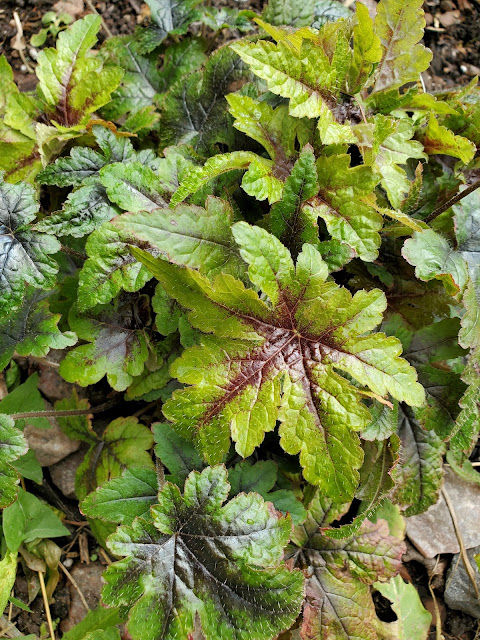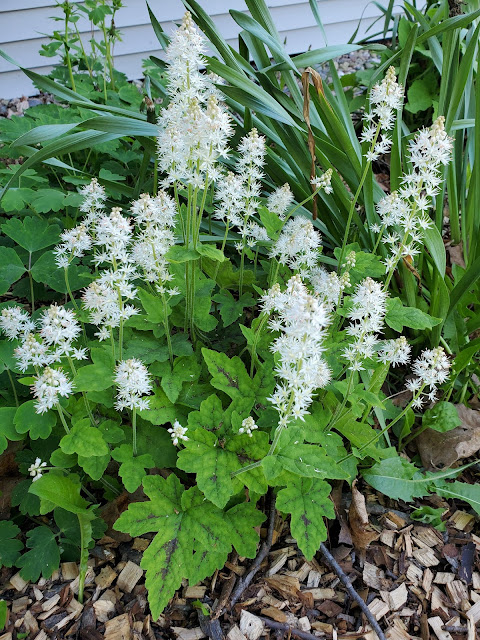Tiarella is a genus of woodland perennials found mostly in North America, with one species currently known from Asia. Closely related to Heuchera, the two genera can be hybridized to create the sterile intergeneric hybrid xHeucherella.
Taxonomic work is still ongoing, with different authorities having drastically differing species listings. World Flora Online lists T. californica, T. cordifolia, T. laciniata, T. macrophylla, T. polyphylla, T. trifoliata, T. trifoliata var. laciniata, T. unifoliata, and T. wherryi as accepted names. The glaring problem with this list is that T. trifoliata var. laciniata and T. laciniata are the same plant! The USDA database lists T. cordifolia var. austrina, T. cordifolia var. collina (synonym for T. wherryi), T. cordifolia var. cordifolia (syn. T. macrophylla), T. trifoliata var. laciniata (syn. T. laciniata and T. californica), T. trifoliata var. trifoliata, and T. trifoliata var. unifoliata. These varieties are separated by questionable morphology that doesn't seem to hold up across their range, there is definitely overlap. T. polyphylla seems to be the only species with not much controversy about its taxonomic status, though I'd be unsurprised if other species were discovered in Asia. Confused yet? That's ok, so is everyone else!
Fortunately, as gardeners, we're dealing primarily with hybrids. Or if you're a native plant nerd, you're probably dealing with more local sources and a deep dive into taxonomy isn't really necessary; you just need to know how close to home your plants originated.
 |
| Tiarella mass planting at Chicago Botanic Garden |
Tiarella grows in bright wooded edges and clearings and fills that niche in gardens as well. Organic rich soils in bright shade or morning sun with dappled light the rest of the day is ideal. As a mass planting with other native woodland species or non-native shade lovers, Tiarella makes a huge impact. If used with ephemerals, the foliage fills in the space left behind after ephemerals go dormant. It blends well with crested Iris or woodland Phlox as well as larger Hostas.
Pollinators really like Tiarella and it's visited by bees, syrphid flies, butterflies, moths, and hummingbirds. Not too much feeds on the foliage, slugs being maybe the worst offender, but damage from them is pretty minimal in the gardens here. Rabbits and deer mostly leave them alone, but will feed on the evergreen foliage in winter if it's not snow covered.
There have been a lot of cultivars introduced over the last 25 years or so. I wouldn't say any are specifically bad and you can easily pick a popular, readily available cultivar and be satisfied with it. It's also easy to pick several varieties for different applications based on growth habit, foliage form, and foliage color.
I am growing 'Sugar and Spice' in full sun right now and it's been quite vigorous with the additional light and water, but I don't recommend this for most people. I had to water a LOT with this year's drought; I only have it planted in its location because in a few seasons it will be more shady once the shrubs fill in and I don't want to renovate. It's close to my hose and a high traffic area, so it's easy to give it extra attention. My friend Larry Conrad uses this variety exclusively in
his gardens planted with
Trillium and
Phlox divaricata. This is a good example that if you only grow one variety you'll probably be happy with it, regardless which it is.
 |
Tiarella 'Sugar and Spice'
|
 |
| Tiarella 'Brandywine' in early spring |
'Brandywine' is a broadleaf hybrid of
T. cordifolia and I was impressed with the heavy bud set I saw in potted plants just emerging from dormancy several years ago. The foliage still had burgundy and bronze tones from winter. I like blending this variety with finer foliage textures. If you want a
Tiarella to blend with ferns or sedges, this is a good option for texture contrast.
 |
| Tiarella 'Spring Symphony' |
 |
| Tiarella 'Spring Symphony' |
'Spring Symphony' is an older favorite of mine. It offers a heavy bloom show well distributed over the plant, deeply lobed foliage, and decent growth. Like I talked about with 'Sugar and Spice', I don't think this is any better than other varieties and you could easily grow 'Pink Skyrocket', 'Cutting Edge', 'Gowing' ANGEL WINGS, or any number of others and be just as happy with them.
 |
| Tiarella 'Susquehanna' |
 |
| Tiarella 'Susquehanna' |
'Susquehanna' is another one that I've had around for awhile. It's another
T. cordifolia hybrid like 'Brandywine', but with smaller foliage that's a little more lobed and is slightly rhizomatous. It's grown well in its new location and gave me a great flower show this spring. Flowers lasted a fairly long time as well.
I don't have my own pictures yet and I don't like to use promotional pictures, but I need to at least mention 'Pink Skyrocket' since it's been incredibly popular for a long time. It has deeply lobed leaves like 'Spring Symphony' but the lobes are broader and coarser. Pink buds open to flowers that are blush pink to white. Fall and winter color ranges from orange to bronze. Despite being introduced 20 years ago, it's still one of the top selling varieties overall and one of the best for pink flowers. A new variety, 'Gowing' ANGEL WINGS looks like it might be very similar but with finer-textured leaves and I'm excited to compare the two varieties in 2022.








No comments:
Post a Comment
Note: Only a member of this blog may post a comment.